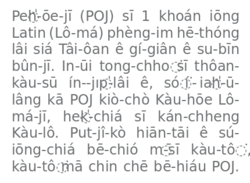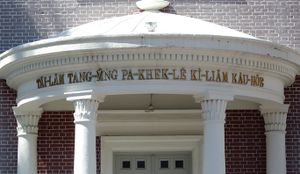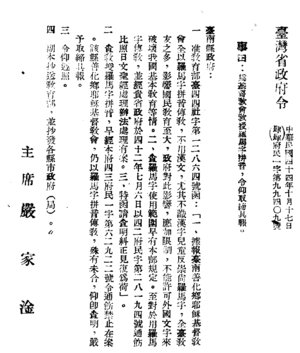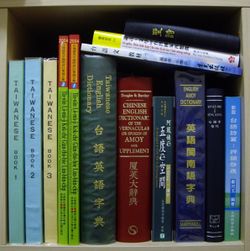پى-وى-جي
| Pe̍h-ōe-jī رومنة الكنيسة | |
|---|---|
 A sample of pe̍h-ōe-jī text | |
| النوع | (معدلة) الأبجدية اللاتينية |
| اللغات | مين الجنوبية |
| المخترع | والتر هنري مدهرست إلايهو دوتي جون ڤان نست تالمدج |
| الفترة الزمنية | ع1830–الحاضر |
النظم الابنة | TLPA Taiwanese Romanization System |
پى-وى-جي (Pe̍h-ōe-jī ، وتُنطق قالب:IPA-nan واختصارها POJ، وتعني حرفياً كتابة العامية، وتُعرف كذلك بإسم رومنة الكنيسة) هي قواعد الكتابة المستخدَمة لكتابة تنويعات من صينية مين الجنوبية، وخصوصاً مين الجنوبية التايوانية وهوكين آموي. وقد طوّرها الإرساليون الغربيون العاملون بين الشتات الصيني في جنوب شرق آسيا في القرن التاسع العاشر ونقاها الإرساليون العاملون في شيامن وتاينان، وتستخدم الأبجدية اللاتينية المعدلة وبعض التشكيل لتمثيل اللغة المنطوقة. وبعد النجاح الأولي في فوجيان، وأكبر انتشار لـپى-وى-جي هو في تايوان ، وفي منتصف القرن العشرين، كان هناك ما يزيد على 100,000 شخص يقرأون ويكتبون بالـپى-وى-جي. وثمة كم ضخم من المواد المطبوعة، الدينية والحياتية، موجود بتلك الكتابة، بما فيها صحيفة تايوان الأولى، Taiwan Church News.
وأثناء فترة تايوان تحم الحكم الياباني (1895–1945)، كـُبـِت استخدم پى-وى-جي وواجه المزيد من الإجراءات المضادة أثناء فترة الأحكام العرفية من الكومنتانگ (1947–1987). وفي فوجيان، use declined after the establishment of the People's Republic of China (1949) and in the early 21st century the system was not in general use there. Taiwanese Christians, non-native learners of Southern Min, and native-speaker enthusiasts in Taiwan are among those that continue to use Pe̍h-ōe-jī. Full native computer support was developed in 2004, and users can now call on fonts, input methods, and extensive online dictionaries. Rival writing systems have evolved, and there is ongoing debate within the Taiwanese mother tongue movement as to which system should be used. Versions of pe̍h-ōe-jī have been devised for other Chinese varieties, including Hakka and Teochew Southern Min.
الاسم
| پى-وى-جي | |||||||||||||||||||||||||||||||||||||
|---|---|---|---|---|---|---|---|---|---|---|---|---|---|---|---|---|---|---|---|---|---|---|---|---|---|---|---|---|---|---|---|---|---|---|---|---|---|
| الصينية التقليدية | 白話字 | ||||||||||||||||||||||||||||||||||||
| الحروف المبسطة | 白话字 | ||||||||||||||||||||||||||||||||||||
| هوكين POJ | Pe̍h-ōe-jī | ||||||||||||||||||||||||||||||||||||
| المعنى الحرفي | كتابة العامية | ||||||||||||||||||||||||||||||||||||
| |||||||||||||||||||||||||||||||||||||
الاسم پى-وى-جي pe̍h-ōe-jī (الصينية: 白話字; پنين: Báihuà zì) يعني "كتابة العامية"، هو عبارة عن حروف مكتوبة تمثل اللغة الدارجة المنطوقة المستخدمة يومياً.[1] الاسم كتابة العامية يمكن تطبيقه على عدة أنواع من الكتابة، منها المُرَوْمَن والمبني على حروف، ولكن المصطلح پى-وى-جي pe̍h-ōe-jī يشيع حصره على نظام رومنة مين الجنوبية الذي طورته الإرساليات المشيخية في القرن التاسع عشر.[2]
التاريخ
تاريخ پى-وى-جي تأثر بشكل كبير بالمواقف الرسمية تجاه لكنات مين الجنوبية والهيئات المسيحية التي تنشره. وتشير الوثائق المبكرة إلى الغرض من خلق پى-وى-جي، وهو التعليمي بطبيعته، والمرتبط تماماً بتعليم معتنقي المسيحية الجدد.[3]
التطور المبكر
Medhurst was convinced that accurate representation and reproduction of the tonal structure of Southern Min was vital to comprehension:
Respecting these tones of the Chinese language, some difference of opinion has been obtained, and while some have considered them of first importance, others have paid them little or no intention. The author inclines decidedly to the former opinion; having found, from uniform experience, that without strict attention to tones, it is impossible for a person to make himself understood in Hok-këèn.
— W. H. Medhurst[4]
بعد الحرب العالمية الثانية
النظام الحالي
| الحروف الكبرى | A | B | Ch | Chh | E | G | H | I | J | K | Kh | L | M | N | Ng | O | O͘ | P | Ph | S | T | Th | U | |
|---|---|---|---|---|---|---|---|---|---|---|---|---|---|---|---|---|---|---|---|---|---|---|---|---|
| الحروف الصغرى | a | b | ch | chh | e | g | h | i | j | k | kh | l | m | n | ⁿ | ng | o | o͘ | p | ph | s | t | th | u |
The initials are:[5]
| Bilabial | Alveolar | Alveolo-palatal | Velar | Glottal | ||||||
|---|---|---|---|---|---|---|---|---|---|---|
| Voiceless | Voiced | Voiceless | Voiced | Voiceless | Voiced | Voiceless | Voiced | Voiceless | ||
| Nasal | [[Bilabial nasal|m [m]]] ㄇ 毛 (mo͘ ) |
[[Alveolar nasal|n [n]]] ㄋ 耐 (nāi) |
[[Velar nasal|ng [ŋ]]] ㄫ 雅 (ngá) |
|||||||
| Stop | Unaspirated | [[Voiceless bilabial stop|p [p]]] ㄅ 邊 (pian) |
[[Voiced bilabial stop|b [b]]] ㆠ 文 (bûn) |
[[Voiceless alveolar stop|t [t]]] ㄉ 地 (tē) |
[[Voiceless velar stop|k [k]]] ㄍ 求 (kiû) |
[[Voiced velar stop|g [g]]] ㆣ 語 (gí) |
||||
| Aspirated | [[Voiceless bilabial stop|ph [pʰ]]] ㄆ 波 (pho) |
[[Voiceless alveolar stop|th [tʰ]]] ㄊ 他 (thaⁿ) |
[[Voiceless velar stop|kh [kʰ]]] ㄎ 去 (khì) |
|||||||
| Affricate | Unaspirated | [[Voiceless alveolar affricate|ch [ts]]] ㄗ 曾 (chan) |
[[Voiced alveolar affricate|j [dz]]] ㆡ 熱 (joa̍h) |
[[Voiceless alveolo-palatal affricate|chi [tɕ]]] ㄐ 尖 (chiam) |
[[Voiced alveolo-palatal affricate|ji [dʑ]]] ㆢ 入 (ji̍p) |
|||||
| Aspirated | [[Voiceless alveolar affricate|chh [tsʰ]]] ㄘ 出 (chhut) |
[[Voiceless alveolo-palatal affricate|chhi [tɕʰ]]] ㄑ 手 (chhiú) |
||||||||
| Fricative | [[Voiceless alveolar fricative#Voiceless alveolar sibilant|s [s]]] ㄙ 衫 (saⁿ) |
[[Voiceless alveolo-palatal sibilant|si [ɕ]]] ㄒ 寫 (siá) |
[[Voiceless glottal fricative|h [h]]] ㄏ 喜 (hí) | |||||||
| Lateral | [[Alveolar lateral approximant|l [l]]] ㄌ 柳 (liú) |
|||||||||
Vowels:[6]
|
| |||||||||||||||||||||||||||||||||||||||||||
Coda endings:
|
|
POJ has a limited amount of legitimate syllables, although sources disagree on some particular instances of these syllables. The following table contains all the licit spellings of POJ syllables, based on a number of sources:
| Licit POJ syllables |
|---|
| ∅ | b | ch | chh | g | h | j | k | kh | l | m | n | ng | p | ph | s | t | th | ||
|---|---|---|---|---|---|---|---|---|---|---|---|---|---|---|---|---|---|---|---|
| a | a | ba | cha | chha | ga | ha | ka | kha | la | ma | na | nga | pa | pha | sa | ta | tha | a | |
| aⁿ | aⁿ | chaⁿ | chhaⁿ | haⁿ | kaⁿ | khaⁿ | phaⁿ | saⁿ | taⁿ | thaⁿ | aⁿ | ||||||||
| ah | ah | bah | chah | chhah | hah | kah | khah | lah | nah | pah | phah | sah | tah | thah | ah | ||||
| ahⁿ | hahⁿ | sahⁿ | ahⁿ | ||||||||||||||||
| ai | ai | bai | chai | chhai | gai | hai | kai | khai | lai | mai | nai | ngai | pai | phai | sai | tai | thai | ai | |
| aiⁿ | aiⁿ | chaiⁿ | haiⁿ | kaiⁿ | khaiⁿ | phaiⁿ | taiⁿ | aiⁿ | |||||||||||
| ak | ak | bak | chak | chhak | gak | hak | kak | khak | lak | pak | phak | sak | tak | thak | ak | ||||
| am | am | cham | chham | gam | ham | kam | kham | lam | sam | tam | tham | am | |||||||
| an | an | ban | chan | chhan | gan | han | kan | khan | lan | pan | phan | san | tan | than | an | ||||
| ang | ang | bang | chang | chhang | gang | hang | kang | khang | lang | pang | phang | sang | tang | thang | ang | ||||
| ap | ap | chap | chhap | hap | kap | khap | lap | sap | tap | thap | ap | ||||||||
| at | at | bat | chat | chhat | hat | kat | khat | lat | pat | sat | tat | that | at | ||||||
| au | au | bau | chau | chhau | gau | hau | kau | khau | lau | mau | nau | ngau | pau | phau | sau | tau | thau | au | |
| auh | chhauh | kauh | lauh | mauh | nauh | phauh | tauh | auh | |||||||||||
| e | e | be | che | chhe | ge | he | ke | khe | le | me | ne | nge | pe | phe | se | te | the | e | |
| eⁿ | eⁿ | cheⁿ | chheⁿ | heⁿ | keⁿ | kheⁿ | peⁿ | pheⁿ | seⁿ | teⁿ | theⁿ | eⁿ | |||||||
| eh | eh | beh | cheh | chheh | heh | keh | kheh | leh | meh | neh | ngeh | peh | seh [ك] | teh | theh [ك] | eh | |||
| ehⁿ | hehⁿ | khehⁿ | ehⁿ | ||||||||||||||||
| ek | ek | bek | chek | chhek | gek | hek | kek | lek | pek | phek | sek | tek | thek | ek | |||||
| eng | eng | beng [ك] | cheng | chheng | geng | heng | keng | kheng | leng | peng | pheng | seng | teng | theng | eng | ||||
| i | i | bi | chi | chhi | gi | hi | ji | ki | khi | li | mi | ni | pi | phi | si | ti | thi | i | |
| iⁿ | iⁿ | chiⁿ | chhiⁿ | hiⁿ | kiⁿ | khiⁿ | siⁿ | tiⁿ | thiⁿ | iⁿ | |||||||||
| ia | ia | chia | chhia | gia | hia | jia | kia | khia | mia | nia | ngia | sia | tia | ia | |||||
| iaⁿ | iaⁿ | chiaⁿ | chhiaⁿ | hiaⁿ | kiaⁿ | piaⁿ | siaⁿ | tiaⁿ | thiaⁿ | iaⁿ | |||||||||
| iah | iah | chiah | chhiah | giah | hiah | kiah | khiah | liah | piah | phiah | siah | tiah | thiah | iah | |||||
| iahⁿ | hiahⁿ | iahⁿ | |||||||||||||||||
| iak | chhiak | khiak | piak | phiak | siak | tiak | iak | ||||||||||||
| iam | iam | chiam | chhiam | giam | hiam | jiam | kiam | khiam | liam | siam | tiam | thiam | iam | ||||||
| ian | ian | bian | chian | chhian | gian | hian | jian | kian | khian | lian | pian | phian | sian | tian | thian | ian | |||
| iang | iang | chiang | chhiang | giang | hiang | jiang | khiang | liang | piang | phiang | siang | iang | |||||||
| iap | iap | chiap | chhiap | giap | hiap | jiap | kiap | khiap | liap | siap | tiap | thiap | iap | ||||||
| iat | iat | biat | chiat | chhiat | giat | hiat | jiat | kiat | khiat | liat | piat | phiat | siat | tiat | thiat | iat | |||
| iau | iau | biau | chiau | chhiau | giau | hiau | jiau | kiau | khiau | liau | miau | niau | ngiau | piau | phiau | siau | tiau | thiau | iau |
| iauⁿ | iauⁿ | iauⁿ | |||||||||||||||||
| iauh | hiauh | khiauh | ngiauh | iauh | |||||||||||||||
| ih | bih | chih | chhih | khih | mih | nih | pih | phih | sih | tih | thih | ih | |||||||
| im | im | chim | chhim | gim | him | jim | kim | khim | lim | sim | tim | thim | im | ||||||
| in | in | bin | chin | chhin | gin | hin | jin | kin | khin | lin | pin | phin | sin | tin | thin | in | |||
| io | io | bio | chio | chhio | gio | hio | jio | kio | khio | lio | pio | phio | sio | tio | thio | io | |||
| ioh | ioh | chioh | chhioh | gioh | hioh | kioh | khioh | lioh | sioh | tioh | ioh | ||||||||
| iok | iok | chiok | chhiok | giok | hiok | jiok | kiok | khiok | liok | siok | tiok | thiok | iok | ||||||
| iong | iong | chiong | chhiong | giong | hiong | jiong | kiong | khiong | liong | siong | tiong | thiong | iong | ||||||
| ip | ip | chip | chhip | hip | jip | kip | khip | lip | sip | ip | |||||||||
| it | it | bit | chit | chhit | hit | jit | kit | khit | pit | phit | sit | tit | it | ||||||
| iu | iu | biu | chiu | chhiu | giu | hiu | jiu | kiu | khiu | liu | niu | piu | siu | tiu | thiu | iu | |||
| iuⁿ | iuⁿ | chiuⁿ | chhiuⁿ | hiuⁿ | kiuⁿ | khiuⁿ | siuⁿ | tiuⁿ | iuⁿ | ||||||||||
| iuhⁿ | iuhⁿ | hiuhⁿ | iuhⁿ | ||||||||||||||||
| m | m | hm | m | ||||||||||||||||
| mh | hmh | mh | |||||||||||||||||
| ng | ng | chng | chhng | hng | kng | khng | mng | nng | png | sng | tng | thng | ng | ||||||
| ngh | chhngh | hngh | phngh | sngh | ngh | ||||||||||||||
| o | o | bo | cho | chho | go | ho | ko | kho | lo | po | pho | so | to | tho | o | ||||
| oⁿ | oⁿ | hoⁿ | koⁿ | oⁿ | |||||||||||||||
| o͘ | o͘ | bo͘ | cho͘ | chho͘ | go͘ | ho͘ | ko͘ | kho͘ | lo͘ | mo͘ | no͘ | ngo͘ | po͘ | pho͘ | so͘ | to͘ | tho͘ | o͘ | |
| oa | oa | boa | choa | chhoa | goa | hoa | koa | khoa | loa | moa | noa | poa | phoa | soa | toa | thoa | oa | ||
| oaⁿ | oaⁿ | chhoaⁿ | hoaⁿ | koaⁿ | khoaⁿ | poaⁿ | phoaⁿ | soaⁿ | toaⁿ | thoaⁿ | oaⁿ | ||||||||
| oah | oah | boah | choah | chhoah | hoah | joah | koah | khoah | loah | poah | phoah | soah | thoah | oah | |||||
| oai | oai | hoai | koai | khoai | soai | oai | |||||||||||||
| oaiⁿ | oaiⁿ | choaiⁿ | hoaiⁿ | koaiⁿ | soaiⁿ | oaiⁿ | |||||||||||||
| oan | oan | boan | choan | chhoan | goan | hoan | koan | khoan | loan | poan | phoan | soan | toan | thoan | oan | ||||
| oang | oang | chhoang | oang | ||||||||||||||||
| oat | oat | boat | choat | goat | hoat | koat | khoat | loat | poat | phoat | soat | toat | thoat | oat | |||||
| oe | oe | boe | choe | chhoe | goe | hoe | joe | koe | khoe | loe | poe | phoe | soe | toe | oe | ||||
| oeh | oeh | boeh | goeh | hoeh | koeh | khoeh | poeh | phoeh | soeh | oeh | |||||||||
| oh | oh | choh | chhoh | hoh | koh | loh | poh | phoh | soh | toh | thoh | oh | |||||||
| o͘h | mo͘h | o͘h | |||||||||||||||||
| ohⁿ | ohⁿ | hohⁿ | ohⁿ | ||||||||||||||||
| ok | ok | bok | chok | chhok | gok | hok | kok | khok | lok | pok | phok | sok | tok | thok | ok | ||||
| om | om | som | tom | om | |||||||||||||||
| ong | ong | bong | chong | chhong | gong | hong | kong | khong | long | pong | phong | song | tong | thong | ong | ||||
| u | u | bu | chu | chhu | gu | hu | ju | ku | khu | lu | pu | phu | su | tu | thu | u | |||
| uh | uh | chuh | chhuh | khuh | puh | phuh | tuh | thuh | uh | ||||||||||
| ui | ui | bui | chui | chhui | gui | hui | kui | khui | lui | mui | pui | phui | sui | tui | thui | ui | |||
| un | un | bun | chun | chhun | gun | hun | jun | kun | khun | lun | pun | phun | sun | tun | thun | un | |||
| ut | ut | but | chut | chhut | hut | kut | khut | lut | put | phut | sut | tut | thut | ut | |||||
| ∅ | b | ch | chh | g | h | j | k | kh | l | m | n | ng | p | ph | s | t | th |
Sources: Campbell,[7] Embree,[8] Kì.[9]
علامات التنغيم
| Number | Diacritic | Chinese tone name | Example listen |
| 1 | none | 陰平 (yinping) dark level |
kha foot; leg |
| 2 | acute | 上聲 (shangsheng) rising |
chúi water |
| 3 | grave | 陰去 (yinqu) dark departing |
kàu arrive |
| 4 | none | 陰入 (yinru) dark entering |
bah meat |
| 5 | circumflex | 陽平 (yangping) light level |
ông king |
| 7 | macron | 陽去 (yangqu) light departing |
tiōng heavy |
| 8 | vertical line above | 陽入 (yangru) light entering |
jo̍ah hot |
أمثلة صوتية
| POJ | الترجمة | Audio File |
|---|---|---|
| Sian-siⁿ kóng, ha̍k-seng tiām-tiām thiaⁿ. | A teacher/master speaks, students quietly listen. | listen |
| Kin-á-jit hit-ê cha-bó͘ gín-á lâi góan tau khòaⁿ góa. | Today that girl came to my house to see me. | listen |
| Thài-khong pêng-iú, lín-hó. Lín chia̍h-pá--bē? Ū-êng, to̍h lâi gún chia chē--ô͘! | Space friends, how are you? Have you eaten yet? When you have the time, come on over to eat. | Listen (from NASA Voyager Golden Record) |
الوضع الحالي
Most native Southern Min speakers in Taiwan are unfamiliar with POJ or any other writing system for the variety,[10] commonly asserting that "Taiwanese has no writing",[11] or, if they are made aware of POJ, considering romanization as the "low" form of writing, in contrast with the "high" form (Chinese characters).[12] For those who are introduced to POJ alongside Han-lo and completely Chinese character-based systems, a clear preference has been shown for all-character systems, with all-romanization systems at the bottom of the preference list, likely because of the preexisting familiarity of readers with Chinese characters.[13]
الهوامش
| نقحرة الصينية |
|---|
| Mandarin |
| Wu |
| Yue |
| Min |
| Gan |
| Hakka |
| Xiang |
| Polylectal |
| See also |
- Notes
- ^ Klöter (2005), p. 90.
- ^ Klöter (2002), p. 1.
- ^ Klöter (2005), p. 92.
- ^ Medhurst (1832), p. viii.
- ^ Chang (2001), p. 30.
- ^ Chang (2001), p. 33.
- ^ Campbell (1913), pp. 1–4: Entries under the initial ts have been tallied under the modern spelling of ch.
- ^ Embree (1973).
- ^ Kì (2008), pp. 4–25.
- ^ Ota (2005), p. 20.
- ^ Baran (2004), p. 35–5.
- ^ Chiung (2005), p. 300.
- ^ Chiung (2005), p. 301.
- Bibliography
- Ang, Ui-jin (1992). Taiwan Fangyan zhi Lü (A Journey Through Taiwanese Regional Speech) (in Chinese). Taipei: Avanguard Publishing. ISBN 957-9512-31-0.
{{cite book}}: Invalid|ref=harv(help)CS1 maint: unrecognized language (link)
وصلات خارجية
عامة
- "Tai-gu Bang". – Google group for Taiwanese language enthusiasts – uses POJ and Chinese characters.
- "Pe̍h-ōe-jī Unicode Correspondence Table" (PDF). Tailingua. 2009. – information on Unicode encodings for POJ text
- "Taiwanese Romanization Association". – group dedicated to the promotion of Taiwanese and Hakka romanization
وسائل الإدخال
- "Open Vanilla". – open source input method for both Windows and Mac OS X.
- "Taigi-Hakka IME". – Windows-based input method for both Hokkien and Hakka variants.
- "Tai-lo Input Method" (in Chinese).
{{cite web}}: CS1 maint: unrecognized language (link) – cross-platform input method released by Taiwan's Ministry of Education. - "Transliterator". – extension for the Firefox browser which allows POJ input in-browser.
فونتات متوافقة مع پى-وى-جي
- "Charis SIL". SIL International. – serif font in regular, bold, italic, and bold italic.
- "DejaVu". – available in serif, sans-serif, and monospace.
- "Doulos SIL". SIL International. – Times New Roman-style serif.
- "Gentium". SIL International. – open source serif.
- "Linux Libertine". – GPL and OPL-licensed serif.
- "Linux Libertine G". – GPL and OPL-licensed serif.
- "Taigi Unicode". – serif font specifically designed for POJ.
نصوص ومعاجم
- "Taiwanese bibliography". – list of books in Taiwanese, including those written in POJ.
- "Memory of Written Taiwanese". – collection of Taiwanese texts in various orthographies, including many in POJ.
- "Tai-Hoa Dictionary". – dictionary which includes POJ, Taiwanese in Chinese characters, and Mandarin characters. Some English definitions also available.
- Exhibits: Taiwanese Romanization Peh-oe-ji, http://www.de-han.org/pehoeji/exhibits/index.htm – sample images of various older POJ texts.
- Chinese Character to Pe̍h-ōe-jī Online Transliterator, http://transliterationisfun.blogspot.com/2016/01/chinese-character-to-southern-min.html - Transliterates Southern Min Characters and Mandarin Characters to POJ.
- Harv and Sfn no-target errors
- Articles with hatnote templates targeting a nonexistent page
- Missing redirects
- Articles containing صينية-language text
- Articles containing traditional Chinese-language text
- Pages with plain IPA
- Articles containing Min Nan Chinese-language text
- قواعد كتابة اللغات
- لغات تايوان
- رومنة الصينية
- من الجنوبية
- صينية هاكـّا
- رومنة هوكين
- نظام كتابة هوكين




